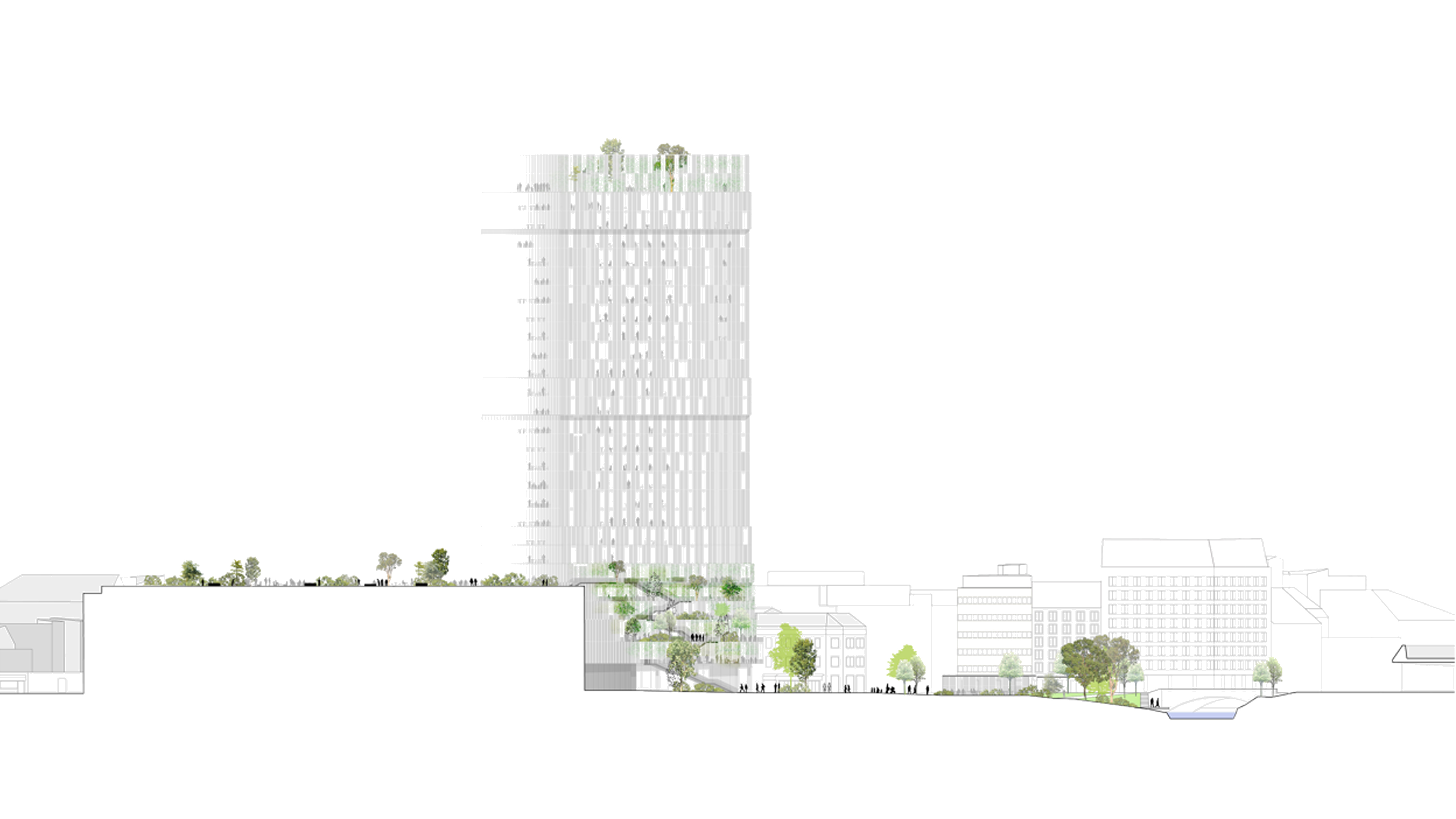






















Urban+ Lilletorget 1
_
date: 2015
status: sketch project
type: office, commerical
client: entra

We are proud to announce that we were the finalists of the Urban+ design and innovation competition for an office building in the centre of Oslo.
Supertree takes the Cradle-to-Cradle original thinkers seriously and makes it real: Design buildings as trees and cities as forests. It is a building that can become a climate regulator which produces more energy than it uses, can store CO2, can use materials with a measurable positive impact on humans, can reduce and recycle the use of other materials and can create a healthy, safe, beautiful and inspiring environment.

URBAN CONTEXT
Lilletorget is a central location in Oslo, close to downtown facilities and public transport. With a future development of the Oslo Central Station, it will become even more populated by pedestrians going to and from the station through the north/south-directed station hall. The site will become a part of a strong sequence of urban spaces in downtown Oslo.
Supertree intends to connect to the park, redefines Lilletorget and lets it become the main square in-between buildings to enable more activity and social control. Vaterlandsparken will be activated by pavilions, both as a meeting room used by people working at Lilletorget 1, and more public programs such as a bike repair shop. Our goal is to create a more vital urban space and a more pedestrian and bicycle friendly circulation.
Supertree project becomes a part of the already existing tower cluster concentrated and developing around Plaza Hotel and Posthuset. We believe that densifying the urban structure in this area is necessary to meet the environmental challenges of the future.
ARCHITECTURAL CONCEPT
Specificity of the urban context on one side and requirements and ambitions related to environmental goals are architectural starting points of the Supertree project.
Adjusting, reinterpreting and connecting to existing surroundings and pathways shapes the base of the building. Supertree reflects existing heights in the area, from the landscape of Vaterland park on east side of the site, buildings surrounding Lilletorget towards north, Spectrum to the west and Plaza Hotel tower towards south.
Body of the building turns upwards and towards the sun. It adjusts its shape and orientation in the way that optimizes the potential for production of the energy and maximizes sunlight exposure of the Vaterland park and surrounding areas. The tower part of the building is positioned in a way that reduces and minimises shading of the immediate surroundings.
Shape of the building reflects programmatic division inside of the building. First three floors of the base being shopping/commercial program opened to the general public and activating Vaterland park and Lilletorget. The meeting centre, canteen and the main reception of the office tower are in the forth to sixth floor. The office tower spreads from seventh to twenty-sixth floor, ending up with the roof terrace and a restaurant that provides great views of the city and can be made accessible to the general public.
In this way architecture of the Supertree provides one specific answer that is tailored to unique urban context and the situation.
Supertree explores the new and exciting architectonic potential of wood as the main structural material for medium to high-rise buildings. New and unique expressions are developed in the meeting between the monumental scale of the wooden structure and the lightness and transparency of the new glass facade. The maximum transparency and extensive use of glass is made possible by innovative Active Energy System.
ENVIRONMENTAL STRATEGIES
Our sustainable strategy is to use materials, construction methods, energy systems and installation infrastructure that follow the main principles of the C2C approach: Mimic closed loops of natural process, maximise the use of renewable energy for the construction and exploitation of the building and design the best-tailored solution to create a healthy environment for this specific location. At the same time these kinds of interventions have to be economically viable, and this is the other important guiding principle of our proposal.
Supertree uses massive timber elements as the essential structural material for a high-rise building, which is a natural, healthy, renewable and, in this case, a local material.
Supertree is an Active House Concept that harvests energy and excess heat trapped in the building as well as harnessing ambient energy by means of storage techniques adapted to local conditions and opportunities, to supply in situ renewable energy when most needed.
Supertree is a sunflower. The building body and skin is optimised for the collection of as much high quality energy as possible. Highly efficient chilled PV panels mounted on the south, southeast and west facade produce electricity and turn this project into a truly active plus-house.
The real challenge lies in proposing the above solutions that radically improve the environmental performance while balancing the costs with market willingness. Our approach is the concept of a new and innovative, yet proven ways to meet the challenges of tomorrow.



